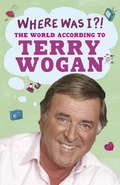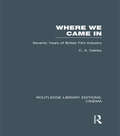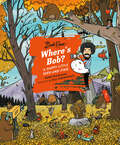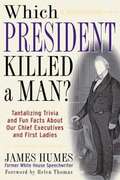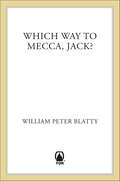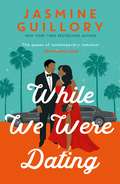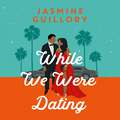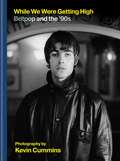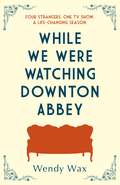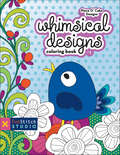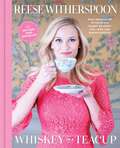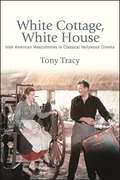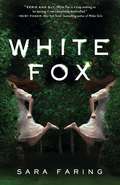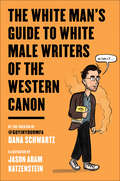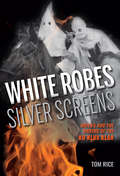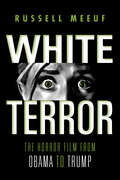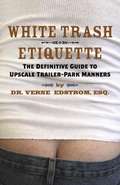- Table View
- List View
Where Was I?!: The World According to Wogan
by Sir Terry Wogan OBEUnadulterated Wogan - the voice of sanity in a world gone gently mad.Until recently, eight million people improved their mornings by tuning into Terry's words of wisdom on Wake up to Wogan. But was their appetite sated by this daily exposure? Not in the slightest. So it's lucky that Terry has been known to turn his hand to the odd bit of writing. This has allowed him to shed light on such weighty matters as how to survive a wedding, what Bank Holidays are for, why Eurovision could be responsible for the Celtic Tiger, whether we should watch out for potatoes, and where exactly it all went pear-shaped... WHERE WAS I? gives his devoted followers exactly what they want - the unadulterated, inimitable Wogan viewpoint; a droll, forthright voice of sanity in a world gone gently mad (or is it them?). Like his broadcasting, his writing is an effortless flow of easy wit and sage opinion. WHERE WAS I? builds up a picture not only of Terry's world, but of Terry himself - a man who somehow manages to be off the wall and on the money all at the same time.
Where Was I?!: The World According to Wogan
by Sir Terry Wogan OBEEight million people improve their mornings by tuning into Terry's words of wisdom on Wake up to Wogan. But is their appetite sated by this daily exposure? Not in the slightest. So it's lucky that Terry has been known to turn his hand to the odd bit of writing. This has allowed him to shed light on such weighty matters as how to survive a wedding, what Bank Holidays are for, why Eurovision could be responsible for the Celtic Tiger, whether we should watch out for potatoes, and where exactly it all went pear-shaped ... WHERE WAS I? gives his devoted followers exactly what they want - the unadulterated, inimitable Wogan viewpoint; a droll, forthright voice of sanity in a world gone gently mad (or is it them?). Like his broadcasting, his writing is an effortless flow of easy wit and sage opinion. WHERE WAS I? builds up a picture not only of Terry's world, but of Terry himself - a man who somehow manages to be off the wall and on the money all at the same time. Never less than funny, and never less than frank, WHERE WAS I? demonstrates exactly how he has come to be regarded as a national treasure.(p) 2009 Orion Publishing Group
Where Was I?!: The World According To Wogan
by Terry WoganUnadulterated Wogan - the voice of sanity in a world gone gently mad.Until recently, eight million people improved their mornings by tuning into Terry's words of wisdom on Wake up to Wogan. But was their appetite sated by this daily exposure? Not in the slightest. So it's lucky that Terry has been known to turn his hand to the odd bit of writing. This has allowed him to shed light on such weighty matters as how to survive a wedding, what Bank Holidays are for, why Eurovision could be responsible for the Celtic Tiger, whether we should watch out for potatoes, and where exactly it all went pear-shaped... WHERE WAS I? gives his devoted followers exactly what they want - the unadulterated, inimitable Wogan viewpoint; a droll, forthright voice of sanity in a world gone gently mad (or is it them?). Like his broadcasting, his writing is an effortless flow of easy wit and sage opinion. WHERE WAS I? builds up a picture not only of Terry's world, but of Terry himself - a man who somehow manages to be off the wall and on the money all at the same time.
Where we Came In: Seventy Years of the British Film Industry (Routledge Library Editions: Cinema)
by Charles Allen OakleyOriginally published in 1964, this book tells the history of the British cinematograph industry for the first time. It describes moments of splendid triumph and others of shattering failure. The mood switches from reckless optimism to demoralising pessimism, from years in which British films won the highest international awards to those when they were dismissed with scorn. It recalls a score of productions still ranked among the world's best, and the stars whose reputation was established in them. Attention is focused on the directors, those who kept to the fore during two and three decades and those with only one major success to their name. Behind them the men are identified who strove, often to their considerable financial loss, to gain a worthy place for British films in the world’s markets.
Where's Bob?: A Happy Little Seek-and-Find
by Robb PearlmanWhere's Bob? On a mountaintop? In a wooded forest? Maybe a TV studio? Find the world's favorite painting instructor in more than a dozen unique settings within this original search-and-find activity book. Where's Bob? includes 15 full-color illustrated scenes to search for Bob Ross in sites reminiscent of his paintings, such as at a riverbank, the seaside, or woods, as well as settings inspired by the artist's life experiences, including a TV studio and shopping mall. The book also invites you to find items like Peapod the squirrel, Bob's paint palette, and his paintbrush within the illustrations. Happy searching!
Which Lie Did I Tell?
by William GoldmanFrom the Oscar-winning screenwriter of Butch Cassidy and the Sundance Kid and The Princess Bride (he also wrote the novel), and the bestselling author of Adventures in the Screen Trade comes a garrulous new book that is as much a screenwriting how-to (and how-not-to) manual as it is a feast of insider information.If you want to know why a no-name like Kathy Bates was cast in Misery-it's in here. Or why Linda Hunt's brilliant work in Maverick didn't make the final cut-William Goldman gives you the straight truth. Why Clint Eastwood loves working with Gene Hackman and how MTV has changed movies for the worse-William Goldman, one of the most successful screenwriters in Hollywood today, tells all he knows. Devastatingly eye-opening and endlessly entertaining, Which Lie Did I Tell? is indispensable reading for anyone even slightly intrigued by the process of how a movie gets made.From the Trade Paperback edition.
Which President Killed a Man? Tantalizing Trivia and Fun Facts About Our Chief Executives and First Ladies
by James HumesFrom the Book jacket: Which president had the lowest approval rating in the twentieth century? Which president fathered a child at age seventy? Which first lady was responsible for bringing the cherry trees to Washington? Which president wrote bawdy limericks as a hobby? Who was the first president of the United States? (Hint: It's not George Washington.) Which president enlisted Elvis Presley in the war against drugs? Who was the only first lady to be committed to a mental institution? And, do you know ... WHICH PRESIDENT KILLED A MAN??? The commander in chief has always made headlines-but what about the tantalizing tidbits that don't make it into the history books? After serving several generations of presidents, author and former White House speechwriter James Humes now offers a delightful smorgasbord of little-known facts and figures about our presidents and their first ladies. James Humes was a White House speechwriter for Presidents Eisenhower, Nixon, Ford, Reagan, and George H. W. Bush. He assisted former President Ford in writing his memoirs, A Time to Heal, and is the author of more than thirty books, including his autobiography: Confessions of a White House Ghost Writer. Currently Ryals Professor of Leadership and Language at the University of Southern Colorado, he has appeared on "Today," "Good Morning America," CNN, "Larry King Live," and hundreds of radio shows. Humes makes his home in Pueblo, Colorado.
Which Way to Mecca, Jack?: From Brooklyn To Beirut: The Adventures Of An American Sheik
by William Peter BlattyBefore William Peter Blatty was the New York Times bestselling author of The Exorcist, he penned a series of comic articles for The Saturday Evening Post about his experiences in the Middle East. Which Way to Mecca, Jack?: From Brooklyn to Beirut: The Adventures of an American Sheik is his hilarious, semi-autobiographical story, based on the Post articles, originally inspired by his two-year stint in Lebanon working for the United States Information Agency.At the Publisher's request, this title is being sold without Digital Rights Management Software (DRM) applied.
While We Were Dating: The sparkling new rom-com from the ‘queen of contemporary romance' (Oprah Mag)
by Jasmine Guillory'It's no wonder Oprah Winfrey and Reese Witherspoon are fans of Jasmine Guillory - she writes the sexiest and smartest romances. This tale . . . ticks all the romcom boxes' Red MagazineHave you discovered New York Times bestseller and Reese Witherspoon Book Club pick Jasmine Guillory yet? 'The queen of contemporary romance' OprahMag.comReaders are loving While We Were Dating!'What can I say.....wonderful! Great writing, great characters and a great storyline... A compelling and thoroughly enjoyable read from start to finish...all capped off by skilful writing' 5* reader review'This book was so lovely (as all of Guillory's books are)... Ben was a great romantic hero: sexy and smart but also kind and respectful...Highly recommended!' 5* reader review'This was my first Jasmine Guillory book, and it won't be the last!''A great summer read...I always enjoy Jasmine Guillory's books and this did not disappoint'Can a Hollywood romance work in the real world? Ben Stephens has never been one to mix business and pleasure, but when he lands a huge ad campaign featuring movie star, Anna Gardiner, and it turns out she's as funny and down-to-earth as she is gorgeous, Ben can't help flirting a little. Anna Gardiner is hoping this ad campaign will be a great distraction while she waits to hear if she's booked her dream role, but she doesn't anticipate that Ben Stephens might be an even bigger distraction... After a family emergency and a late-night road trip moves them past light-hearted flirtation, Ben and Anna grow closer. But when Anna's manager decides to use their fling to help Anna's Hollywood career, will Ben be content to play the background role in Anna's life and leave when the cameras stop rolling? Or could he be the leading man she's looking for?PERFECT FOR FANS OF SOPHIE RANALD, JO WATSON and ZARA STONELEY!'A charming, warm, sexy gem' Roxane Gay, New York Times bestselling author If you love this, be sure to check out The Wedding Date, The Proposal, The Wedding Party, Royal Holiday and Party of Two!
While We Were Dating: The sparkling fake-date rom-com from the ‘queen of contemporary romance' (Oprah Mag)
by Jasmine Guillory'It's no wonder Oprah Winfrey and Reese Witherspoon are fans of Jasmine Guillory - she writes the sexiest and smartest romances. This tale . . . ticks all the romcom boxes' Red MagazineHave you discovered New York Times bestseller and Reese Witherspoon Book Club pick Jasmine Guillory yet? 'The queen of contemporary romance' OprahMag.comCan a Hollywood romance work in the real world? Ben Stephens has never been one to mix business and pleasure, but when he lands a huge ad campaign featuring movie star, Anna Gardiner, and it turns out she's as funny and down-to-earth as she is gorgeous, Ben can't help flirting a little. Anna Gardiner is hoping this ad campaign will be a great distraction while she waits to hear if she's booked her dream role, but she doesn't anticipate that Ben Stephens might be an even bigger distraction... After a family emergency and a late-night road trip moves them past light-hearted flirtation, Ben and Anna grow closer. But when Anna's manager decides to use their fling to help Anna's Hollywood career, will Ben be content to play the background role in Anna's life and leave when the cameras stop rolling? Or could he be the leading man she's looking for?PERFECT FOR FANS OF SOPHIE RANALD, JO WATSON and ZARA STONELEY!'A charming, warm, sexy gem' Roxane Gay, New York Times bestselling author If you love this, be sure to check out The Wedding Date, The Proposal, The Wedding Party, Royal Holiday and Party of Two!(P) 2021 Penguin Audio
While We Were Getting High: Britpop & the ‘90s in photographs with unseen images
by Kevin CumminsA ROUGH TRADE BOOK OF THE YEAR"To flip through the book is to be immersed back in the glory days of Cool Britannia... and it's just as cool as you remember"GQRemember Britpop and the '90s through hundreds of its most striking images - with many seen here for the very first time. Taken by renowned photographer Kevin Cummins, chief photographer at the NME for more than a decade, the images in this book explore the rise and fall of Cool Britannia and all that came with it.Nostalgic, anarchic and featuring contributions from icons of the Britpop era including Noel Gallagher and Brett Anderson, While We Were Getting High is a seminal portrait of a decade like no other.Artists featured include:OasisBlurSuedePulpElasticaSupergrassThe CharlatansGeneSleeperKula ShakerEchobellyThe Bluetones...and many more
While We Were Getting High: Britpop & the ‘90s in photographs with unseen images
by Kevin CumminsA ROUGH TRADE BOOK OF THE YEAR"To flip through the book is to be immersed back in the glory days of Cool Britannia... and it's just as cool as you remember"GQRemember Britpop and the '90s through hundreds of its most striking images - with many seen here for the very first time. Taken by renowned photographer Kevin Cummins, chief photographer at the NME for more than a decade, the images in this book explore the rise and fall of Cool Britannia and all that came with it.Nostalgic, anarchic and featuring contributions from icons of the Britpop era including Noel Gallagher and Brett Anderson, While We Were Getting High is a seminal portrait of a decade like no other.Artists featured include:OasisBlurSuedePulpElasticaSupergrassThe CharlatansGeneSleeperKula ShakerEchobellyThe Bluetones...and many more
While We Were Watching Downton Abbey: The perfect feel-good novel for anyone who loves 'Downton Abbey'
by Wendy WaxFour strangers, one addictive drama, and a season of surprises. . .When Edward invites his neighbours to watch Downton Abbey, he never imagines that his weekly screenings will change the lives of three very different women . . .Samantha married for the wrong reason: security for herself and her orphaned brother and sister. But marriage is more complicated than she expected, particularly when a family betrayal shatters everything.Claire left her empty nest in the suburbs for a new life. As she struggles to find her feet, she worries that she's clinging to a hopeless dream.And then there's Brooke, in a constant battle with her faithless ex-husband, and trying to accept that her life isn't the fairy tale she always wanted.Drawn together by the joy, heartbreak and glamour of Downton Abbey, the four unlikely friends begin to forge a connection to the show - and to each other - that will help them through the interweaving drama of their own lives . . .The perfect uplifting read for fans of Downton Abbey!
Whimsical Designs Coloring Book
by FunStitch StudioColoring has never been this creative. Get inspired with 18 different designs you can color or draw or paint all day. Add your own flair with pens, pencils, crayons, markers or paint. Learn how colors go together and try out a new color theory today. • Keep yourself busy in the car, while waiting for friends - anywhere you go • Decorate your room, your binder, or your locker with finished pages, or give them to friends • Collect the whole series! Each book features designs by different quilt artists Whimsical Designs has 18 whimsical birds, animals, and flowers to color, plus fun facts about appliqué. *Free table-top display available with purchase of 12 coloring books! (Wholesale minimum: 3 units.)
Whisker Wizard (Babymouse Tales from the Locker #5)
by Jennifer L. HolmWatch out, Internet! Babymouse is about to #influence you in the next book in the Babymousetastic, highly illustrated Babymouse: Tales from the Locker series.Babymouse's whiskers are in a twist! Literally. She tries out a new style--the twist--and now everyone wants to know her whisker secrets. When she posts a tutorial online, it immediately goes viral. Babymouse is officially a whisker influencer! But being an online celebrity is no piece of cake! There are trolls, receipts, and tea that somehow gets spilled. #Huh? Can Babymouse hold on to internet fame and keep her whiskers on point? And will someone please explain to her what all these words mean?!
Whiskey in a Teacup: What Growing Up in the South Taught Me About Life, Love, and Baking Biscuits
by Reese WitherspoonAcademy award–winning actress, producer, and entrepreneur Reese Witherspoon invites you into her world, where she infuses the southern style, parties, and traditions she loves with contemporary flair and charm.Reese Witherspoon’s grandmother Dorothea always said that a combination of beauty and strength made southern women “whiskey in a teacup.” We may be delicate and ornamental on the outside, she said, but inside we’re strong and fiery. Reese’s southern heritage informs her whole life, and she loves sharing the joys of southern living with practically everyone she meets. She takes the South wherever she goes with bluegrass, big holiday parties, and plenty of Dorothea’s fried chicken. It’s reflected in how she entertains, decorates her home, and makes holidays special for her kids—not to mention how she talks, dances, and does her hair (in these pages, you will learn Reese’s fail-proof, only slightly insane hot-roller technique). Reese loves sharing Dorothea’s most delicious recipes as well as her favorite southern traditions, from midnight barn parties to backyard bridal showers, magical Christmas mornings to rollicking honky-tonks. It’s easy to bring a little bit of Reese’s world into your home, no matter where you live. After all, there’s a southern side to every place in the world, right?
Whisper
by Chris Struyk-BonnSixteen-year-old Whisper, who has a cleft palate, lives in an encampment with three other young rejects and their caregiver, Nathanael. They are outcasts from a society (in the not-too-distant future) that kills or abandons anyone with a physical or mental disability. Whisper’s mother visits once a year. When she dies, she leaves Whisper a violin, which Nathanael teaches her to play. Whisper’s father comes to claim her, and she becomes his house slave, her disfigurement hidden by a black veil. But when she proves rebellious, she is taken to the city to live with other rejects at a house called Purgatory Palace, where she has to make difficult decisions for herself and for her vulnerable friends.
White Cottage, White House: Irish American Masculinities in Classical Hollywood Cinema (SUNY series, Horizons of Cinema)
by Tony TracyWhite Cottage, White House examines how Classical Hollywood cinema developed and deployed Irish American masculinities to negotiate, consolidate, and reinforce hegemonic whiteness in midcentury America. Largely confined to discriminatory stereotypes during the silent era, Irish American male characters emerge as a favored identity with the introduction of sound, positioned in a variety of roles as mediators between the marginal and mainstream. The book argues that such characters function to express hegemonic whiteness as ethnicity, a socio-racial framing that kept immigrant origins and normative American values in productive tension. It traces key Irish American male types—the gangster, the priest, the cop, the sports hero, and the returning immigrant—who navigated these tensions in maintenance of an ethnic whiteness that was nonetheless "at home" in America, transforming from James Cagney's "public enemy" to John Wayne's "quiet man" in the process. Whether as figures of Depression-era social disruption, avatars of presidential patriarchy and national manhood, or allegories of postwar white flight and the nuclear family, Irish American masculinities occupied a distinctive and unrivaled visibility and role in popular American film.
White Fox
by Sara FaringAfter their world-famous actor mother disappeared under mysterious circumstances, Manon and Thaïs left their remote Mediterranean island home—sent away by their pharma-tech tycoon father. Opposites in every way, the sisters drifted apart in their grief. Yet their mother's unfinished story still haunts them both, and they can't put to rest the possibility that she is still alive.Lured home a decade later, Manon and Thaïs discover their mother’s legendary last work, long thought lost: White Fox, a screenplay filled with enigmatic metaphors. The clues in this dark fairytale draw them deep into the island's surreal society, into the twisted secrets hidden by their glittering family, to reveal the truth about their mother—and themselves. An Imprint Book
The White Indians of Mexican Cinema: Racial Masquerade throughout the Golden Age (SUNY series in Latin American Cinema)
by Mónica García BlizzardThe White Indians of Mexican Cinema theorizes the development of a unique form of racial masquerade—the representation of Whiteness as Indigeneity—during the Golden Age of Mexican cinema, from the 1930s to the 1950s. Adopting a broad decolonial perspective while remaining grounded in the history of local racial categories, Mónica García Blizzard argues that this trope works to reconcile two divergent discourses about race in postrevolutionary Mexico: the government-sponsored celebration of Indigeneity and mestizaje (or the process of interracial and intercultural mixing), on the one hand, and the idealization of Whiteness, on the other. Close readings of twenty films and primary source material illustrate how Mexican cinema has mediated race, especially in relation to gender, in ways that project national specificity, but also reproduce racist tendencies with respect to beauty, desire, and protagonism that survive to this day. This sweeping survey illuminates how Golden Age films produced diverse, even contradictory messages about the place of Indigeneity in the national culture.This book is freely available in an open access edition thanks to TOME (Toward an Open Monograph Ecosystem)—a collaboration of the Association of American Universities, the Association of University Presses, and the Association of Research Libraries—and the generous support of Emory University and the Andrew W. Mellon Foundation. Learn more at the TOME website, available at: https://www.openmonographs.org/. It can also be found in the SUNY Open Access Repository at http://hdl.handle.net/20.500.12648/7153
White Line Fever: The Autobiography
by Lemmy Garza Janiss KilmisterOne of music's most notorious frontmen leads a headbanging, voyeuristic odyssey into sex, drugs, and rock 'n' roll that rivals Motley Crue's The Dirt and Aerosmith's Walk This Way. <P><P>He made Keith Richards look like a choirboy and Mick Jagger look like a nun. And as the head of the legendary band Motorhead, he ploughed his way through so many drugs, so many women, and so much alcohol, that he gave a whole new meaning to the term Debauchery. And he changed the face of music, conquering the rock world with such songs as Ace of Spades, Bomber, and Overkill and inventing a whole new form of music--speed metal. At the age of 57, Lemmy Kilmister remains a rock icon, both for his monumental talent and his hedonistic lifestyle. In White Line Fever, he recounts his incredible, pleasure-filled, and death-defying journey through music history. Born on Christmas Eve, 1945, in Wales, to a vicar and a librarian, Ian Fraser Kilmister learned early, he as he forthrightly puts it, what an incredible pussy magnet guitars were. A teenager at the birth of rock 'n' roll, Lemmy idolized Elvis and Buddy Holly and soon joined a band of his own. He would eventually head to London, where he became a roadie for Jimi Hendrix, played in Opal Butterfly, and joined space rockers Hawkwind's lineup in 1971. Four years later, speedfreak Lemmy was fired from the band for doing the wrong drugs. Vowing to form the dirtiest rock 'n' roll band in the world, he formed Motorhead, arguably the heaviest and loudest heavy metal band to ever take the stage. During their twenty-seven-year history, Motorhead would go on to release twenty-one albums, including the #1 record No Sleep 'Til Hammersmith and would earn a Grammynomination. Lemmy would also cheat death on more than one occasion, most notoriously in 1980, when his doctor told him, I cannot give you a blood transfusion because normal blood will kill you. . . and your blood would kill another human being, because you're so toxic. But through more than two decades of notorious excess, Lemmy has lived to tell the warts-and-all tale of a life lived over the edge. White Line Fever, a tour of overindulgence, metal, and the search for musical integrity, offers a sometimes hilarious, often outrageous, and always unbridled ride with the leader of the loudest rock band in the world. "
The White Man's Guide to White Male Writers of the Western Canon
by Dana Schwartz Jason Adam KatzensteinThe White Man's Guide to White Male Writers of the Western Canon is a hilarious exploration of the literary world from Dana Schwartz, aka @GuyInYour MFA.Illustrations by Jason Adam KatzensteinHow do you use ‘taraddidle’ in a sentence? Is it possible to make a Gin Ricky that’s also a metaphor for the American Dream? How can you tell your Faulkner from your Franzen if you haven’t actually read either?Allow me, the @GuyInYourMFA, to expound on the most important (aka white male) writers of western literature. You’ve probably seen me around, observing the masses, or defying the wind by hand-rolling a cigarette outside a local, fair-trade coffee shop. I’ve actually read Infinite Jest nine and a half times. Care to discuss?From Shakespeare's greatest mystery (how could a working-class man without access to an MFA program be so prolific?) to the true meaning of Kafkaesque (you know you've made it when you have an adjective named for you), the pages herewith are at once profound and practical. Use my ingenious Venn diagram to test your knowledge of which Jonathan—Franzen, Lethem, or Safran Foer—hates Twitter and lives in Brooklyn. (Trick question: all three!) Sneer at chick-lit and drink Mojitos like Hemingway (not like middle-aged divorcées!).So instead of politely nodding along next time you make an acquaintance at a housewarming party in Brooklyn, you can roll up your sleeves and get to work schooling them in character arcs and the experimental form of your next great American novel. Dazzle your friends with how well you understand post-modernism. You’ll be at a literary event asking a question “that’s really more of a comment” in no time.
White Robes, Silver Screens
by Tom RiceThe Ku Klux Klan was reestablished in Atlanta in 1915, barely a week before the Atlanta premiere of The Birth of a Nation, D. W. Griffith's paean to the original Klan. While this link between Griffith's film and the Klan has been widely acknowledged, Tom Rice explores the little-known relationship between the Klan's success and its use of film and media in the interwar years when the image, function, and moral rectitude of the Klan was contested on the national stage. By examining rich archival materials including a series of films produced by the Klan and a wealth of documents, newspaper clippings, and manuals, Rice uncovers the fraught history of the Klan as a local force that manipulated the American film industry to extend its reach across the country. White Robes, Silver Screens highlights the ways in which the Klan used, produced, and protested against film in order to recruit members, generate publicity, and define its role within American society.
White Terror: The Horror Film from Obama to Trump
by Russell MeeufWhat kinds of terror lurk beneath the surface of White respectability? Many of the top-grossing US horror films between 2008 and 2016 relied heavily on themes of White, patriarchal fear and fragility: outsiders disrupting the sanctity of the almost always White family, evil forces or transgressive ideas transforming loved ones, and children dying when White women eschew traditional maternal roles. Horror film has a long history of radical, political commentary, and Russell Meeuf reveals how racial resentments represented specifically in horror films produced during the Obama era gave rise to the Trump presidency and the Make America Great Again movement. Featuring films such as The Conjuring and Don't Breathe, White Terror explores how motifs of home invasion, exorcism, possession, and hauntings mirror cultural debates around White masculinity, class, religion, socioeconomics, and more. In the vein of Jordan Peele, White Terror exposes how White mainstream fear affects the horror film industry, which in turn cashes in on that fear and draws voters to candidates like Trump.
White Trash Etiquette
by Verne EdstromThe definitive guide to high-class trailer park living. White Trash Etiquette contains everything you need to know to live like decent trash, including: The proper way to fake a back injury How to prevent your in-laws from stealing the silverware at wedding receptions The 10 Hottest White Trash Career Opportunities How to improve your drunk driving skills Sound advice on everything from lying to your boss to making your next convenience store robbery fun for the whole family There's also troubleshooting for troublemakers: I'm getting married; can I still wear white if I'm a tramp? Can chicks ever really respect an accountant? How do I pick a good bail bondsman? How can I get my 14-year-old cousin unpregnant? And much more.
